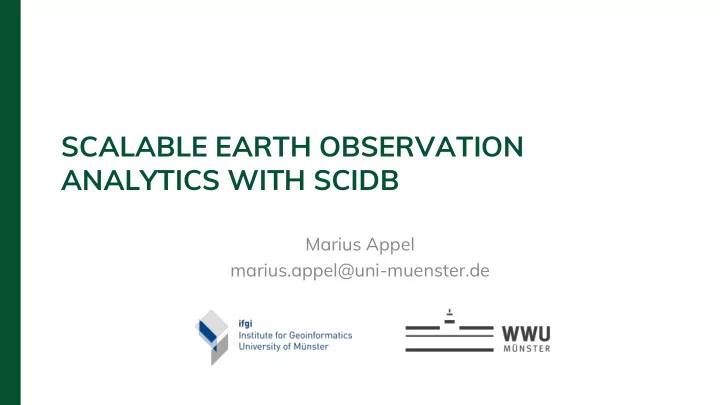

SCALABLE EARTH OBSERVATION ANALYTICS WITH SCIDB Marius Appel marius.appel@uni-muenster.de
EO DATA ORGANIZATION LANDSAT 8 2 2
EO DATA ORGANIZATION SENTINEL 2 3 3
EO DATA ORGANIZATION SENTINEL 2 4 4
EO DATA ORGANIZATION SENTINEL 2 5 5
EO DATA ORGANIZATION SENTINEL 2 6 6
EO DATA ORGANIZATION SENTINEL 2 7 7
EO DATA ORGANIZATION • EO image deployment is file-based • GDAL interfaces EO imagery with GIS software • Difficult to analyze large image collections due to – data volume – Irregularities – lack of time support in GDAL • Higher-level data organization as an alternative to files? – Key requirement: scalability 8 8
SCIDB INTRODUCTION Array-based data management and analytical system [1] • Relies on shared nothing architectures • Open-source version available, extensible by UDFs • Basic data representation as multidimensional arrays: • 𝑜 dimensions, 𝑛 attributes with different data types – latitude time time longitude longitude [1] Stonebraker, M., Brown, P., Zhang, D., & Becla, J. (2013). SciDB: A database management system for applications with 9 9 complex analytics. Computing in Science & Engineering , 15 (3), 54-62.
SCIDB ARCHITECTURE Coordinator Node Clients … Instance Instance Instance Instance 0 1 2 3 Worker Node Worker Node Worker Node Instance Instance Instance Instance Instance Instance 5 9 13 4 8 12 Instance Instance Instance Instance Instance Instance 6 7 10 11 14 15 10
SCIDB ARCHITECTURE arrays are divided into equally • sized chunks chunks are distributed over • many SciDB instances Size and shape of chunks are • defined by users per array and have strong effects on computation times Storage is nearly sparse • 11 11
QUERY LANGUAGE AND FUNCTIONALITY SciDB query language: Array Functional Language (AFL) • Built in functionality: • – Load / write arrays from / to files – Arithmetic operations – subsetting by dimensions, attributes, or values – Aggregations – Joins – Changing array schemas (repartitioning, redimensioning) – Linear algebra routines: (GEMM, GESVD, basic statistics) – … 12 12
EXTENSIONS FOR EO DATA • scidb4geo (https://github.com/appelmar/scidb4geo) – SciDB plugin adds metadata and simple operations on space- time referenced arrays • scidb4gdal (https://github.com/appelmar/scidb4gdal) – ingest / download to / from GDAL supported files – spacetime mosaicing • R package scidbst (https://github.com/flahn/scidbst) – mimics functionality of common packages on SciDB arrays 13 13
SCIDB CLIENTS • Low-level clients: iquery, Shim • High-level R client (similar for Python) – overrides standard methods, e.g. %*% – make extensive use of proxy objects – lazy evaluation: • compute things when result is being read • ignore computations for unread parts of the results 14 14
SCIDB STREAMING • Run external programs (e.g., R, python) within SciDB at chunk level parallelism chunk size selection must be adapted to the analysis 15 15
STUDY CASE: LAND USE CHANGE MONITORING IN SOUTH WEST ETHIOPIA FROM LANDSAT 7 IMAGERY Landsat 7 data from 12 • tiles captured between 2003-07-21 and 2014- 12-27 1975 scenes approx. 325,000 km 2 • monitor changes starting • with 2010-01-01 using R and Breaks For • Additive Season and Trend and its R implementation [1] [1] Verbesselt, J., Hyndman, R., Newnham, G., & Culvenor, D. (2010). Detecting trend and seasonal changes in 16 16 satellite image time series. Remote Sensing of Environment, 114, 106-115. DOI: 10.1016/j.rse.2009.08.014.
EO DATA AS REGULAR ARRAYS 17 17
LANDSAT 7 IN SCIDB Images form a single three-dimensional array with daily temporal resolution and • 49548 x 47713 x 4177 cells in total • Only 0.5% ( 54 ⋅ 10 9 ) of the cells contain data sparse storage 18
STUDY CASE IMPLEMENTATION 1. Ingestion using GDAL 2. Preprocessing (with built-in SciDB functionality) remove any values <= -9999 or >10000 – compute NDVI vegetation index – Reorganize chunks such that one chunk stores complete time series of – 64 x 64 pixels 3. Run R scripts on all chunks using streaming 4. Postprocessing (with built-in SciDB functionality) Reshape one-dimensional result array to form a two-dimensional map – 5. Export results using GDAL 19 19
STUDY CASE: RESULTS 20
STUDY CASE SCALABILITY • 16 SciDB instances • running change analysis repeatedly with different number of available CPU cores 21 21
CONCLUSIONS The array model with chunking and sparse storage seems well-suited to • represent large EO datasets from many scenes at a higher level than files Analyses scale well with available hardware • Little reimplementation needed to scale complex time-series processing • through streaming (and no need to care about parallelization / external memory) Installation and data ingestion not straightforward and time-consuming • Mostly useful for re-analysis but not real-time processing • Missing interactive(!) user interfaces (á la Google Earth Engine) to make the • technology more accessible to end users? 22 22
THANK YOU • Questions? • Hands-on with SciDB tomorrow! • Slides available at GitHub: https://github.com/appelmar/edcforum2017 • Contact marius.appel@uni-muenster.de 23 23
Recommend
More recommend